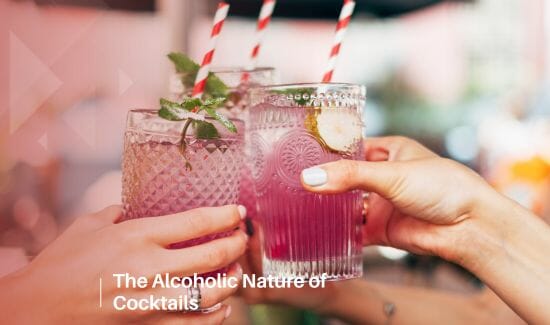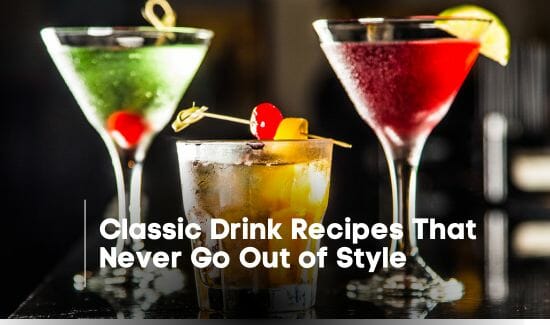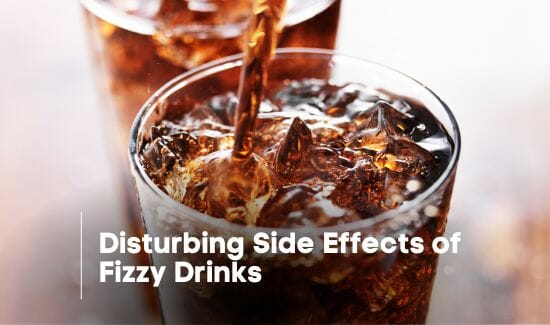
Cocktails are alcoholic beverages that are made by mixing multiple ingredients together. The main alcoholic nature of cocktails is distilled spirits such as vodka, rum, whiskey, gin, and tequila. These distilled spirits have a high concentration of alcohol, usually between 40-50% alcohol by volume (ABV).
In addition to the base spirit, cocktails also contain other ingredients like fruit juices, simple syrups, bitters, soda water, cream, herbs, etc. These additional ingredients complement the flavor of the main spirit and also contribute to the overall alcohol content of the cocktail.
The purpose of combining various alcoholic and non-alcoholic mixers in cocktails is to create a balanced, nuanced flavor profile. However, as a result of mixing multiple alcoholic ingredients, many cocktails end up having a very high alcohol content. Even cocktails that taste relatively sweet and mild can contain as much alcohol as a shot or two of straight spirits.

Factors that Determine Alcohol Nature of Cocktails
- Type of Base Spirit
The type of spirit used as the base of a cocktail can significantly influence its alcoholic strength. Spirits like whiskey, brandy, and rum often have a higher ABV of between 40-50% whereas spirits like vodka and gin have an ABV of around 40%. Using a spirit with a higher ABV can increase the overall alcohol content of the final cocktail.
- Volume of Base Spirit
The amount of base spirit poured into a cocktail also impacts its alcohol concentration directly. Most standard cocktail recipes call for 45ml-60ml of the base spirit per serving. Any increase in this quantity, such as a double shot of spirit in a cocktail, automatically increases the total alcohol content.
- Other Alcoholic Ingredients
Ingredients other than the base spirit also contribute to the overall alcoholic strength of a cocktail. Many cocktails include liqueurs, fortified wines, or spirits-based aperitifs like vermouth or Campari. These tend to have high ABVs ranging from 15% for certain liqueurs up to 20% or above for fortified wines. Their inclusion adds to the alcohol content.
- Dilution by Non-Alcoholic Mixers
Dilution is another key factor. Adding water, fruit juices, syrups or other non-alcoholic mixers dilutes the concentration of alcohol in the final cocktail. A cocktail that uses more fruit juice and less spirit will have a lower ABV than a drier, spirit-forward drink.
Finally, serving cocktails in smaller glasses means the total alcohol quantity is concentrated in less volume, leading to a higher alcohol percentage per serving. A short cocktail glass will have a more concentrated drink than a tall highball glass with the same ingredients.

Alcohol Percentage of Different Spirit Categories
Vodka, gin, and light rum generally have an alcohol-by-volume percentage of around 40%. This means 40% of the total volume of these spirits is pure alcohol. The rest is mostly water along with trace amounts of flavorings or additives. So a 100 ml serving of vodka or gin would contain about 40 ml of actual alcohol.
Whiskies like bourbon and scotch, along with brandies, are higher in ABV compared to vodka and gin. They range from 40% on the lower end for some whiskies to up to 50% or more for cask-strength brandies. A major factor is whether they are drunk straight or diluted. Bourbon may be bottled at 40% but consumed at a higher proof when undiluted.
Liqueurs and fortified wines have the widest range in alcohol content. Many liqueurs like coffee liqueurs or orange liqueurs contain about 20-30% ABV. But some creamy liqueurs are richer in alcohol at 35-55% ABV. Fortified wines are often between 18-22% since they have a wine base fortified with additional spirits. Both add considerable alcohol to cocktails.

Alcohol Content in Common Cocktails
A. Martini Cocktails
- Martinis range from 15-17% ABV on average. Vodka or gin are the primary base spirits around 40% ABV. Vermouth adds some additional alcohol at around 18% ABV. The minimal dilution leads to moderately high alcohol concentration.
B. Manhattan Cocktails
- Manhattans are higher in alcohol at 24-30% ABV. They contain a greater quantity of whiskey which can be 50% ABV or higher. The sweet vermouth also contributes additional alcohol. The lack of juice or other mixers results in a bolder alcoholic punch.
C. Margaritas
- Margaritas contain tequila which is usually 40% ABV. They include liqueurs like triple sec around 20-40% ABV. Fruit juice dilutes the alcohol somewhat, leading to a typical ABV of 15-22%. But blender margaritas with minimal dilution will be higher.
D. Piña Coladas
- Piña coladas range from 16-18% ABV on average. The combination of rum and coconut cream along with pineapple juice creates the flavors. However, the alcohol content is moderated slightly by the fruit juice.
E. Mojitos
- Mojitos are a more diluted, refreshing cocktail ranging from 12-16% ABV. The rum is mixed with mint, lime juice, and soda water which lowers the alcohol concentration significantly compared to spirit-forward cocktails.
F. Long Island Iced Teas
- Despite the name, these contain a high level of alcohol at 22-28% ABV. They include a mix of several spirits totaling 90-120 ml along with lemon juice and cola. The lack of dilution leads to very high alcoholic strength.

Tips for Drinking Cocktails Responsibly
A. Pace Yourself
- Sipping cocktails slowly allows you to gauge your alcohol intake. Take small sips and pause between drinks. Don’t gulp or chug cocktails. Pacing ensures you don’t overdo it.
B. Alternate with Non-Alcoholics
- Have a glass of water or fresh juice between cocktails. Alternating alcoholic and non-alcoholic beverages helps pace consumption and keeps you hydrated.
C. Avoid Mixing Too Many Spirits
- Stick to 1 or 2 base spirits in your cocktails per session. Mixing too many types like vodka, rum, tequila, etc. can lead to excess intoxication.
D. Eat While Drinking
- Having food alongside cocktails can slow down alcohol absorption into the bloodstream. Eat before and during cocktail consumption to moderate alcohol’s effects.
E. Know Your Limits
- Know your personal tolerance levels and stop drinking before reaching intoxication. Be able to say no to a next round when you’ve had enough. Never feel pressured to over-drink.
The key is drinking mindfully, pacing yourself, and stopping at your prudent limit. Moderation and responsibility should dictate cocktail consumption.
Final Words
In conclusion, cocktails are alcoholic mixed drinks that contain distilled spirits as well as liqueurs, wines, fruit juices and other flavorful ingredients. The combination of high-proof alcohols along with lower-proof mixers leads to a wide range of alcoholic nature of cocktails. Factors like the type and quantity of spirits, additional liquors, dilution, and serving glass size impact the total alcohol percentage.
FAQs:
What is the difference between a cocktail and a mocktail?
A cocktail contains alcohol while a mocktail is a non-alcoholic version using similar ingredients. Mocktails allow you to enjoy the flavors without the effects of alcohol.
What cocktails are the lowest in alcohol content?
Cocktails like mojitos, sangria, and mimosas are relatively low in alcohol at around 12-15% ABV due to high juice or soda dilution.
What factors lead to cocktails having higher alcohol content?
Using spirits with a high ABV, minimizing dilution, adding multiple types of liquors, and serving in smaller glasses increases the overall alcohol percentage.
How can you estimate the alcoholic nature of cocktails recipe?
Total the ABV of each alcoholic ingredient based on their typical proof and adjust for dilution from juices, sodas, etc. This will give an approximate idea of the cocktail’s alcoholic strength.
What’s the benefit of using a jigger to measure cocktail ingredients?
A jigger allows you to accurately control the volume of spirits poured, especially higher proof ones, preventing accidentally making drinks with too high alcohol content.

As a dedicated blogger, I share insights, tips, and knowledge on all things caffeinated and beyond. I firmly believe that a well-brewed cup of coffee or a skillfully crafted cocktail has the power to unite people and ignite engaging conversations.



